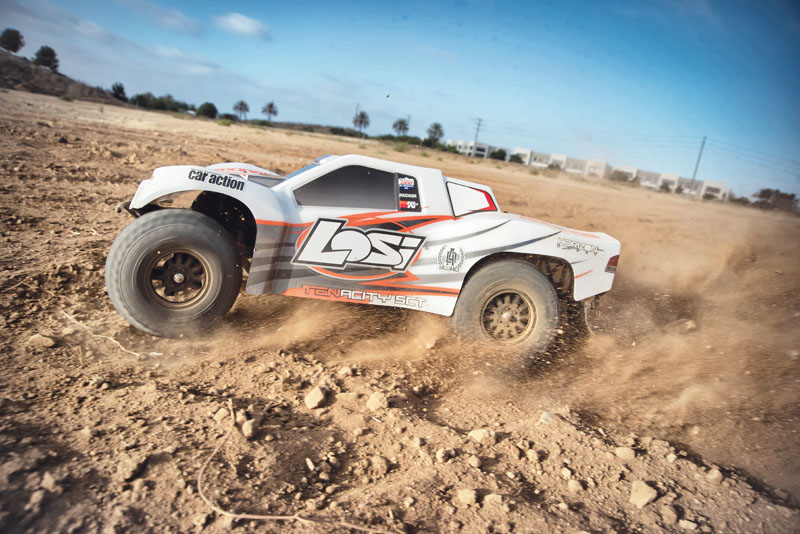From Tekin:
Ryan Lutz taking you through his set-up on his Tekin RX-8 Gen 3 Speed Controller for his Kyosho 1/8th Offroad Buggy.
Check out my website Blog and Store at www.LutzRC.com
Tekin explanations of various settings:
RPM Brake- allows you to set a different brake strength that works off of the motor RPM. This setting adjusts your “slow speed” or “infield brake” power. First you’ll set your normal Brake Strength for high speed areas of the track, so set them how you want them for braking on the straight and for corners at the end of high speed sections. Then you can use RPM brake to increase braking strength at slow speeds, if necessary.
If your car is perfect braking from high speeds, but seems to lack brake strength at slower speeds, like in the infield in tight sections, you can turn RPM Brake up to increase the slow speed brake power.
Brake Minimum- It adjusts the minimum amount of brake the ESC will apply to the motor as soon as trigger brakes are engaged. The higher the value set, the stronger the initial brake power will be. This will also move where full brakes are at on the trigger, so if a setting higher than 0 is used, 100% brake signal is reached before 100% trigger throw.
Push Control- allows you to set some artificial coast to help “push” the car when you let off throttle and go to neutral. It does the exact opposite of Drag Brake, so rather than apply brakes the ESC will keep throttle on and fade to zero throttle so long as you stay in neutral. This can help eliminate drive train drag and assist with entering corners and carrying more momentum everywhere on the track. This setting is most beneficial for stock classes.
Torque Level- controls the initial power delivery or the “punch” your ESC and motor will provide. 1-10 steps are available with 10 being OFF, or full punch with no limiter. The default setting of 8 is a great starting place for most setups and surfaces.
Use 4-7 for most modified setups on lower to medium traction surfaces. 7-9 for high traction surfaces. Setting 10 for any stock or SPEC racing class so no limiter is in effect.
Throttle Minimum- is the minimum throttle power the ESC will apply to the motor when the user induces a throttle application. If you want a stronger initial throttle and higher motor start up RPM, use a higher value. Use a lower value or 0 to have a softer throttle and lower motor start up RPM. For Spec racing, higher values will increase the punch feel.
Throttle Frequency- allows you to adjust how aggressively the throttle on your ESC reacts. Lower values provide a more aggressive feel and higher values provide a more mild feel. This setting can be used to fine-tune the feel you’re looking for on different surfaces.
Default is 6kHz with a range of 2-12kHz available. Lower values are great for stock classes and higher traction surfaces, 5-8kHz are great for most modified and 1/8 electric setups on all surfaces. 9-12kHz soften the low end of the throttle up and can help out if you drive more nitro style.
Brake strength- adjusts the amount of trigger brake the ESC will apply to the motor. There are 1-13 steps available using the onboard QuickTune system, with each step being about 8% brake strength. You can also fine tune the brake strength via the HotWire at a higher resolution of adjustment, with 0-100% steps available.
Brakes are extremely important and you need to adjust them appropriately. Track surface, moisture content, tires and car will all come into play when setting brakes. Typically a good brake strength is going to be 80% or less. I find myself setting even as far down as 55% at times, which really helps me not over brake and carry more speed.
Brake Frequency- changes the pulse width being applied during braking. In general higher frequencies provide a softer brake power and feel with a more usable range of trigger motion, allowing for better brake modulation while keeping full brake power overall. Lower frequency gives more aggressive brakes with a stronger overall feel.
Visit TeamTekin.com
See more posts about Tekin



![How To: Setting Up A Tekin RX8 Gen 3 ESC With Pro Driver Ryan Lutz [VIDEO]](https://www.rccaraction.com/wp-content/uploads/2023/11/How-To-Setting-Up-A-Tekin-RX8-Gen-3-ESC-With-Pro-Driver-Ryan-Lutz-640x300.jpg)




![RC Car Action - RC Cars & Trucks | This 1/3 scale 125cc V10 Buggy is CRAZY [VIDEO]](https://www.rccaraction.com/wp-content/uploads/2018/05/V10-HP.jpg)


 Stay up to date with the latest information, sign up for our FREE newsletter today.
Stay up to date with the latest information, sign up for our FREE newsletter today.
